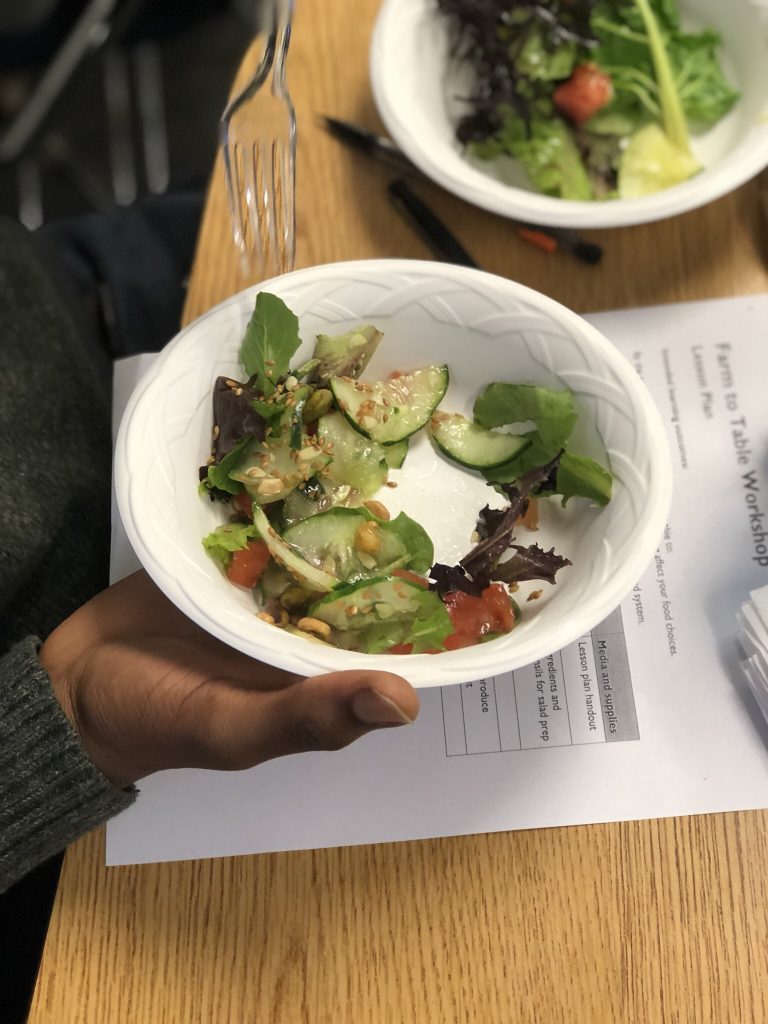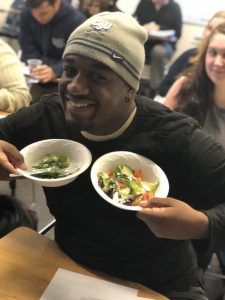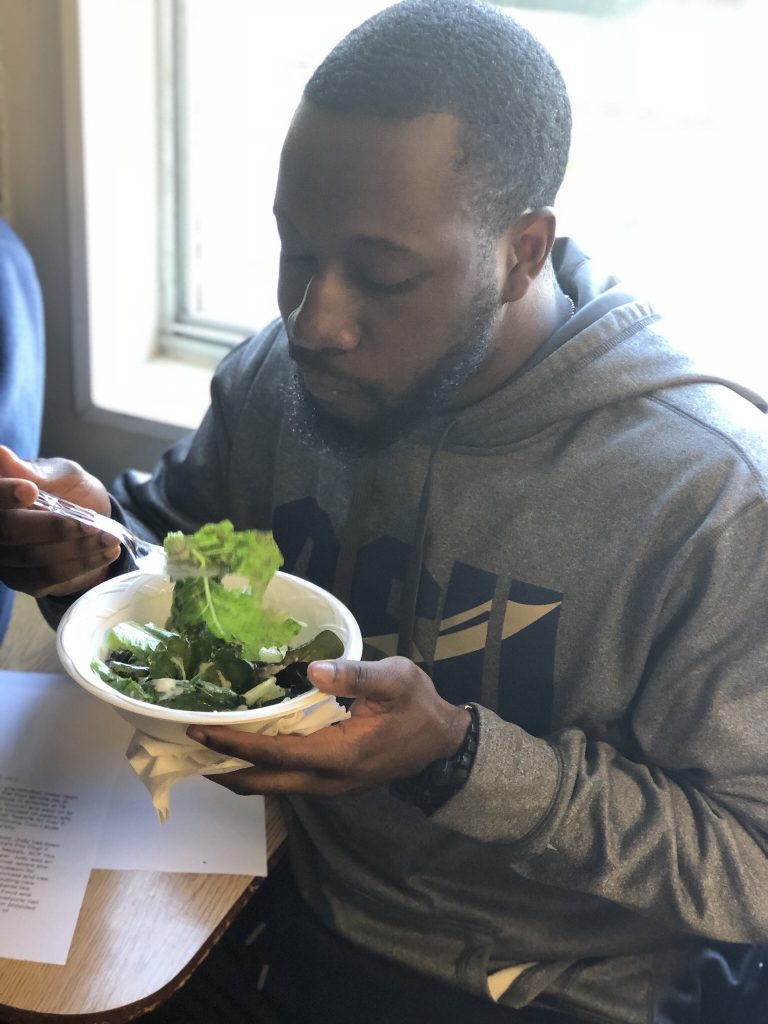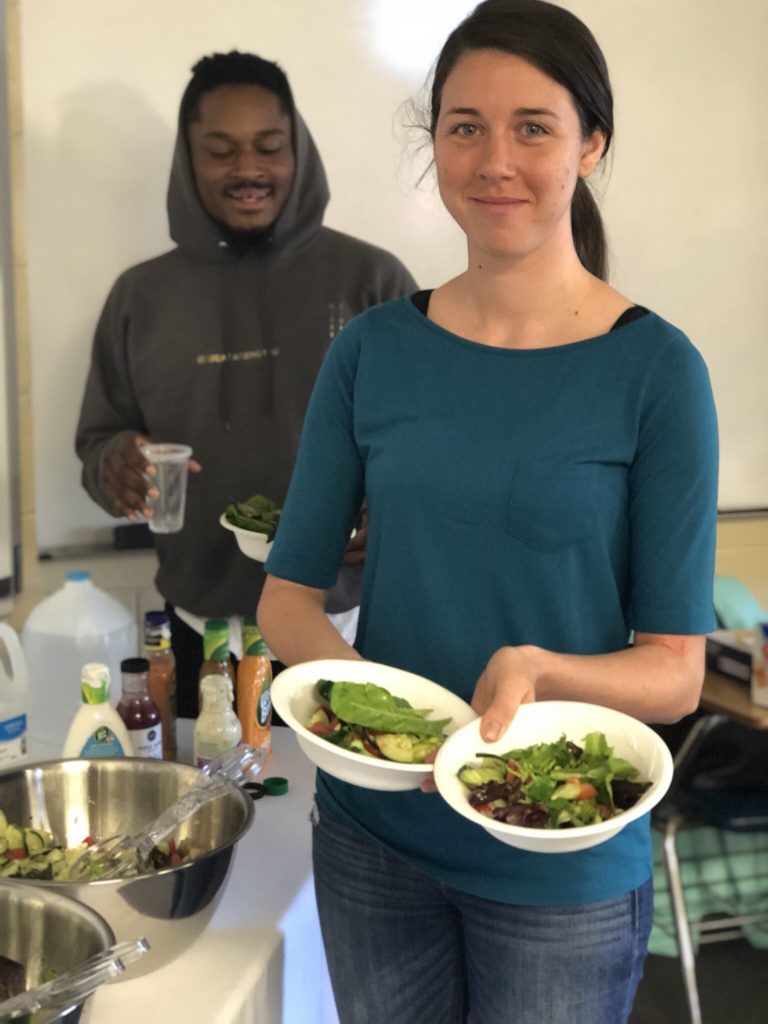
Michelle Nelson, MHA, is a college educator who wanted to bring a farm to table lesson to students at Charleston Southern University. She purchased our farm to table banner and handout items. She called us to ask us for ideas for making an engaging lesson with a 30 minute time limit.
The first idea we gave her was to offer the students a farm-to-table salad bar so they can make their own salads. This requires the ingredients to be prepared in advance since the time frame is so short. But we did give Michelle the idea to enlist the help of the students who want to arrive early or her college cafeteria workers to get it all prepped for their arrival. This is the option that she chose but Michelle went all out and prepared the ingredients the night before in her own kitchen. She kept it simple with fresh lettuce, cucumbers, and tomatoes. She also made a home-made dressing.
Michelle made 2 salad bars for her students.
The first was using ingredients from a farmer’s market and then the second one was using ingredients from a local grocery store. The students could tell the difference right away and they were very exuberant in letting her know that the farmer’s market salad was a lot more delicious and flavorful.
She asked us to skype in for the morning and we agreed. I gave the students a brief overview about the local food market and how many people their age are involved with it from the farming to the food processing and purchases. After all, the local food market is an $8 billion industry.





Here are more activity ideas and resources that we shared with Michelle so she could share the farm with her students. Feel free to use them for yours!
Here is a handout about local food:
https://news. nutritioneducationstore.com/ local-food-lesson/
Maybe a couple of quiz questions with prizes:
https://foodandhealth.com/ category-game-cffh/
Here are some other game ideas:
Pass The Potato
Play pass the potato with your participants. Have everybody name a fruit and then pass the potato on. When someone can’t think of a fruit, they get eliminated. The one who wins has named a fruit that has not been named, every time he or she got the potato. The winner gets a prize such as a bag of baby carrots or a jar of fat-free salad dressing. This gets everyone to really think about all of the options out there, and to realize that he or she is usually always eating the same fruit or vegetable time and time again. You can also play the same game for vegetables.
Mystery Veggie Game
Use this game with a variety of audiences, from kids to older folks. It is easy to do, and you can vary it with seasonally available produce.
1. Place a variety of common and unusual vegetables and/or fruits in clean crew-type socks.
2. Pass the socks around the group. Have each participant feel and smell the item through the sock (without taking it out) and write the name of the item they suspect on a sheet of paper, numbered from 1 to whatever number of items you are using.
3. After everyone has had a chance to feel and smell the items in the socks and record their answers, ask for guesses and pull them out one by one. Discuss the nutritional aspects of each item and possible preparation methods or favorite ways of eating. Sample some of the more unusual or exotic items.
4. Depending on budget and type of event, you can sometimes give some of the produce items individually for prizes or put several in a basket for a bigger prize.
This idea can also be used for wellness fairs. And it will make a GREAT fun game for National Nutrition Month this year since the theme is centered around fruits and vegetables.
Here are our favorites for fruits:
- • star fruit – fun shape
- • kiwi – beautiful color
- • avocado – used like a vegetable but botanically it is a fruit
- • tangerine – easy to eat on the go
- • lemon – great for salads
- • apple – great for snacks
- • pear – easy to guess but makes a great snack
And here are our favorites for vegetables:
- • sweet potato
- • broccoli
- • carrot
- • zucchini
- • egg plant
Create an ongoing challenge
https://foodandhealth.com/ fruit-and-vegetable-challenge/
And here is a recipe handout:
https://foodandhealth.com/ blog/wp-content/uploads/2015/ 08/RawVegetablePlatterHandout. pdf
You can also explain that the farm to table movement was started by a chef and is used by some of the most famous chefs in the world. Here are 2 videos by the chef of Noma which was voted the best in the world last year. They feature local foods from their native Norway.
https://www.youtube.com/watch? v=a4cJJs5bOfs
About Noma and their chef and the use of local cuisine in Norway
This one is an actual scene from eating at Noma: https://www.youtube.com/watch? v=jLpU75kFMNw
NOMA offers a “tasting menu of about 18 different courses and each one is a small bite.
Noma was voted the best restaurant in the world last year by the San Pellegrino Top 50 restaurants in the world and they feature the local Nordic food prepared very fresh in beautiful presentations (we viewed this for my plate presentation class).
Alice Waters of Chez Panisse in Berkeley, CA, started the farm to table movement by purchasing organic produce from local farms near her restaurant and many of the chefs from all over the world today use the concept. They buy local foods and have farms grow their produce. The French Laundry in Yountville CA has its own garden. This was always the premise of the chefs of France.
Here are the benefits of local food:
https://foodandhealth.com/ sustainability-and-local-food- talk-by-marion-nestle-and- alice-waters/